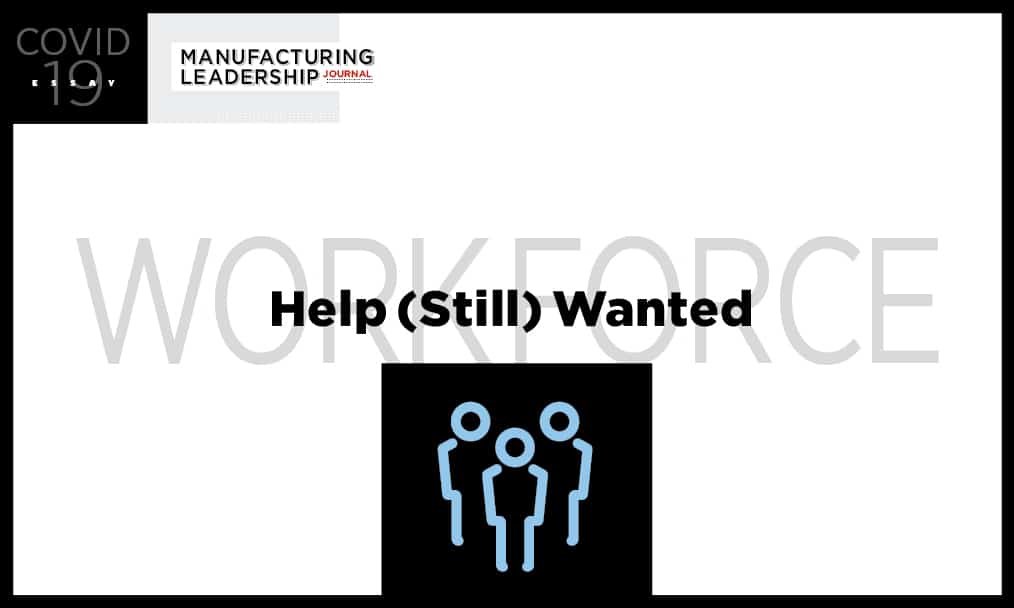
Manufacturers look for new ways to find the essential skilled workers that keep operations going.
In February 2020, the manufacturing sector was entering its 26th consecutive month with nearly 450,000 open jobs and a tight labor market with a 3.5% national unemployment rate. For the 10th quarter in a row, the number one concern for manufacturers was the inability to hire a skilled workforce, according to the National Association of Manufacturers’ quarterly Manufacturers’ Outlook Survey.
Then in mid-March, as COVID-19 spread rapidly across several metropolitan areas, a nationwide shutdown for all but essential businesses began. By the end of April, more than 20 million fewer Americans were on payrolls nationwide. The events of the past few months have left Americans reeling with an unsure outlook on the future.
While manufacturing wasn’t unaffected by layoffs, as of April the industry’s unemployment percentage was below the overall national average as many factories were deemed essential businesses and able to remain open. But as the industry moves closer to recovery, the events and impacts of COVID-19 create a need for a path forward for the workforce. At The Manufacturing Institute, we see that skilled workers will continue to be a critical component for the industry’s post-pandemic growth, and we see an even greater need to elevate our mission to inspire, educate, and empower the manufacturing workforce of today and tomorrow.
Worker safety will be a tantamount concern for manufacturers as they move forward. Whether they are reopening after a shutdown or modifying their existing operations to implement new social distancing practices, manufacturers are forced to reconsider their physical facilities and how people interact with them. They also have the need to educate their workforce on best practices and consider new arrangements like flexible shift start times and the use of virtual technology for connecting with workers, customers, and vendors.
Recruiting and hiring practices have also changed. Interviews have gone virtual. Companies are relying on technology to connect with existing workers and find new talent. The MI has been a part of this shift through its Heroes Connect – Military to Manufacturing effort, an online program that allows manufacturers to connect with veterans transitioning to civilian careers in advanced manufacturing. Solutions like these are likely to become part of long-term practices to recruit and hire skilled manufacturing talent.
The focus on finding individuals with the right skills will continue and presents an opportunity for those seeking a new future.
The pandemic response may also motivate more companies to shift to a high-performance team model to better leverage their skilled workers and encourage worker development. In this model, workers are often trained on a variety of skills and given flexible assignments based on production needs. Workers are also often empowered to make decisions about solving problems. Their career advances as they broaden their skill set while also learning more skills in-depth.
It’s not surprising that the pandemic has also brought up the conversation about more automation in the workplace. If robots can’t get sick, wouldn’t companies want to replace as much of their workforce as possible? However, the answer is not so black and white. While robots have replaced certain shop floor tasks, it is generally those that are difficult for humans to do safely, or those that are more repetitive in nature. While advanced robotics are a growing field, so is the number of robotic programmers and maintenance technicians that manufacturers need to hire in order to keep them operating.
n addition, there hasn’t yet been a way for machines to replicate human innovation. While today’s manufacturing operations are augmented through AI, enormous sets of data, and high-performance computing, it still ultimately takes creators to design the machinery, create the vaccines, reconfigure the supply chains, and ensure that products are safe and reliable. Creators have been, and will continue to be, essential. The focus on finding individuals with the right skills will continue to increase and should be recognized as an opportunity for those searching for a new future.
For many years, the MI along with Deloitte has published the landmark skill gap study for the manufacturing sector. The November 2018 study found that by 2028 the sector would have 4.6 million jobs to fill with 2.4 million going unfilled because we didn’t have the workers with the right skills. While this was pre-COVID-19, right now, the fundamentals of the skills gap have not changed. If the reshoring debate accelerates and policies are enacted to require the domestic manufacture of critical medical supplies and PPE, that will increase the workforce demand even further.
Now more than ever, manufacturers need people with the skills to power America’s renewal. M